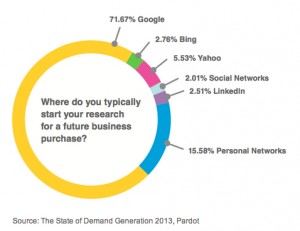Uncategorized

Boost Content Marketing ROI by Giving Away Secrets
 When developing a content marketing strategy for your business, one of the biggest mistakes you can make is to shy away from publishing so-called trade or company secrets. Although you may assume your company’s proprietary information should remain private, divulging “secret” information is in fact one key way you can effectively boost your content marketing ROI.
When developing a content marketing strategy for your business, one of the biggest mistakes you can make is to shy away from publishing so-called trade or company secrets. Although you may assume your company’s proprietary information should remain private, divulging “secret” information is in fact one key way you can effectively boost your content marketing ROI.
This is because content marketing works to serve a specific purpose – building trust between your company and target audience. When you provide a reader with unique and actionable information, that reader has little choice but to believe you are an exceptional industry expert.
You can effectively reach beyond the realm of best-deal shoppers, and enter the coveted land of customer trust and loyalty.
Walking The Line
Of course, there is a fine line to walk between sharing uniquely valuable information and giving away your edge. For example, the Bush Beans company probably shouldn’t give away that secret family recipe their TV commercials are always talking about. But when people are online, they’re looking for information, and a good content marketing strategy needs to focus on supplying that information.
Giving away secrets is the secret ingredient in the recipe for positive content marketing ROI. Bush may be protecting the secret family baked bean recipe, but the company still gives consumers what they want. The Bush Beans website offers a variety of helpful information, ranging from “Kid-Approved Recipes” to nutritional information about beans. The company has developed a solid foundation for a positive content marketing ROI. Your business can do it too.
How to Boost Content Marketing ROI with Secrets
Creating truly effective content for online marketing is no easy task. It takes time, and as the old adage goes, time is money. Consequently, in order to achieve a positive content marketing ROI, your business must invest in quality content and avoid wasting time on fluff.
Churning out words and posting them online isn’t enough to convert readers into customers. The words must be exceptionally valuable.
1. The first step when developing a content marketing strategy that shares valuable secrets is to set aside fear. Don’t be afraid your competitors will steal your mojo. They have their own secrets, and they likely have many of the same secrets that you do.
Also, don’t be afraid your customers will become do-it-yourself practitioners if you give them instructions. If they want to do something themselves, they will – with or without you. If they don’t, your transparency and expertise can help you build enough trust so that they choose your institution to do it for them.
2. The next step is to determine what your target market needs to know about your industry and/or your product/service. More importantly, find out what they need to know that hasn’t already been beaten like a dead horse by other content marketers.
Basically, you need to have the guts to answer the questions that your competitors haven’t already answered. Give away advice. Show your target market that you get it, that you care, and that you’re here to make even the most complex practices seem simple.
3. The third step is to put it all out there. Choose to answer a unique question about your industry and give it all you got. Go in-depth. Take your time. Get into the nitty gritty. A detailed how-to guide or a well-researched white paper will present more value to your potential customers than a fluffy blog post could any day. (Does this qualify as fluffy?)
Content Marketing ROI Boost for Your Industry
If you are ready to provide real value to your target market and build a solid foundation for positive content marketing ROI, consider making sure to publish these three key pieces of online marketing content:
- Industry FAQ – Gather a list of basic questions that newcomers ask, and answer them in a FAQ page on your website or blog.
- Education – Give your target market educational information on their essential concerns regarding your industry and your product/service.
- Benefits of Your Service or Product – Publish a piece of content that not only explains the generic benefits a using your product or service, but also the benefits of getting them from YOUR business.
Achieving a positive content marketing ROI can be quite a challenge, but success comes more easily when you focus on creating valuable content, instead of merely lots of content. Give up secrets. Get transparent. Get real with customers, and persuade them to get real with you.
If you need help creating content for your business, Hat Trick Associates is ready for you. We specialize in content marketing, and we are prepared to show you how your own trade secrets can be utilized to boost your content marketing ROI. Contact us today by calling (314) 494-3494 or by emailing Jim Haynes at jhaynes@hattrickassociates.com.

SEO Content Marketing and B2B Purchase Behavior
SEO Content Marketing and B2B Buyers
Though B2B SEO professionals surely understand the value in web content marketing initiatives, we sometimes fail to understand the level of content commitment required to demonstrate success.
In the Chief Marketing Officer Council’s recent study, titled “The Content Connection to Vendor Selection,” researchers uncovered six distinct personas that all consume different types of content and share that content with other levels within the company.
According to the report, these various buyers consume a spectrum of web content marketing assets in an effort to keep current on new technologies, glean insight and shape purchasing decisions, and (most importantly for B2B vendors) identify potential suppliers, partners and solution providers. Thus, B2B marketers should develop content across all of these personas for maximum exposure.
But, equally important was the fact that most buyers will seek neutral, third party, and fact-driven content when making purchase decisions. This means that vendor content also has to be distributed across third-party sites and social media platforms where buyers actively search and discuss needs. Search is still a critical first step in the vendor discovery process. According to the report, approximately 68 percent start their content sourcing at search engines and portals.
The importance of search was also validated in a recent report from Pardot, as discussed in a MarketingProfs column this past November. In that report, almost three quarters (72%) of buyers planning to purchase a business product begin their research with a Google search, specifically.
With all this in mind, how much content do B2B SEOs really need to demonstrate measurable success in their search engine optimization initiatives?
Web Content Marketing in Action
A Hat Trick Associates client – who we were producing roughly 5 news articles per week for – was faced with the task of generating added online exposure for a fast-moving promotional campaign over 60-day time period. The client needed us to demonstrate a significant, measurable improvement in website traffic very quickly, with a focus on SEO-generated organic traffic growth and improved social media presence.
Content Production: In addition to our regular publication schedule, this client added the following elements to their online marketing program:
- 12 blog posts specificly designed for social media, with an emphasis on viral marketing
- 2 infographics for homepage
- 2 YouTube educational videos
- 3 comprehensive feature articles of approximately 3,000 words, with a fairly extensive amount of research
The new schedule occurred concurrently with regular publishing calendar over that initial 2 month period. The content was heavily broadcast through the organization’s social media profiles (specifically Twitter and LinkedIn) and shared directly with a select PR list as well.
Impact/Results
Over a two-month period, the following SEO performance results were realized from this organization’s content marketing focused efforts.

- Organic search engine traffic grew by 31% from the 2 month period prior
- Third-party traffic grew by 67% in that same period
- Organic search traffic was the highest recorded in the site’s history for February
- Over 1,000 incoming links were added
So the result was a marked improvement in the metrics we were tracking, and the promotion was quite successful. We have experienced similar results for a great many of our clients regarding the production of high-quality website content, both in the short term similar to this campaign, and also in the long term. As your SEO program builds upon itself month after month, you will find that the metrics being tracked will begin to exponentially expand as you continue with your SEO program. I also like to describe your SEO efforts as a marathon – certainly not a sprint, or singular “event” – and that you can run as quickly as your resources will allow. For those spending fewer dollars per month, you will still eventually reach your destination of greatly increased traffic and sales conversions. You simply won’t break any speed records in doing so. Thus for those willing to commit greater financial resources, they will reach the finish line more quickly. And even here in that analogy, though a marathon is a very long process, it is still an “event”. So a marathon that keeps going is an even better description.
If you would like to learn more about how ongoing content writing and distribution can greatly increase your online revenues and profit, please give me a call at (314) 494-3494 or contact me via email at: jhaynes@hattrickassociates.com. As we cater to small and mid-sized businesses, we are also very cognizant of maximizing the ROI on your marketing dollars, and providing you with very good value in comparison to the increased sales conversions you receive. I hope to speak with you sometime soon.
Jim Haynes – Owner, Hat Trick Associates

What Bloggers Must Know About Google Hummingbird
Hat Trick Associates – SEO and Google Hummingbird, Explaining Algorithm Changes
Prior to Google’s Penguin and Panda, SEO (search engine optimization) often repeating keywords and phrases throughout blog posts and webpages. This achieved a higher Page Rank for a website, so SEO strategists figured out what the algorithms were looking for and flooded their content with it. But it didn’t provide much value to the end user.
If you remember those days, many searches would pull up nonsense articles, but which included the key words you were looking for. Searches yielded frustration because you pulled up sites that appeared on the surface to address your needs, but turned out to be bogus sales sites.
If a webmaster wanted to appear on the first page of Google for a competitive (and lucrative) term like “make money online,” he would repeat the phrase approximately 5% of the time in an article. He would also include it in the article’s title and high in the actual text, such as “Make Money Online The Right Way.” The result was useless pages and posts, and unfulfilled search needs.
Another strategy was to use the importance that Google placed on links from other websites using specific anchor text, such as “make money online”, to your advantage. Using this strategy allowed blogger John Chow to raise his ranking from 158 to the coveted number three spot on Google for that lucrative phrase. Google measured backlinks because they figured it was a good sign of the site’s popularity with searches. Chow still enjoys that number three spot, having somehow (with new SEO techniques, surely) survived Google’s numerous algorithm changes.
Google designed the most recent Penguin and Panda algorithms to make searches more effective and valuable for consumers, which meant that the content of articles (finally) rose to supreme importance. The changes benefited consumers because rich content rose to the top of searches rather than hollow shells that offered no real answers or information. The algorithms made SEO more complex than keywords and backlinks, forcing marketers to provide rich content if they wanted to land on Google’s first page.
Web content marketing arose in response, with the idea that solid information, knowledge, and answers provide the most benefit to searchers. Effective marketers found the way to use rich web content to market their product.
Hummingbird Refines Searching with Penguin and Panda
The most recent evolution is Google’s 2013 Hummingbird, which positions search queries and language in primary importance. The update’s name “Hummingbird” reflects the goal of being precise and fast like the animal, focusing on the meaning and intent of the searcher rather than just the words. The algorithm favors titles and content that respond to user needs and queries. The tool can better understand speech, and passes the benefits on to searchers. Think of Google’s Hummingbird as a super smart and ultra-fast reader.
The following methods will help you in working with SEO for your blog or webpages in general:
– Write rich, high quality content that responds to user needs
Google’s shift toward making results pages more valuable to readers favors rich content, helping people who are looking for your writing. Rather than focusing exclusively on key terms and littering the article with repeated phrases, articles should deliver quality content, with reliable information and credible references. As long as you focus your article on a key idea, you won’t have to worry about using terms repeatedly.
Adapt your writing to meet the needs of the reader, anticipating answers to the questions they have. You should still research key terms and see the traffic they are generating, but pay attention to the heart of your reader’s question and what they need, focusing on full phrases and sentences instead of two word combinations.
– Write long, in-depth content
You should always be in the process of re-purposing old content, a topic for another day. But for now replace the thin pages of your website, articles of 250 words or fewer, with content that delves deep into an issue or challenge that concerns your readers. Your writing needs to be solid. Not just lengthy blathering to fill pages, but 800 to 1200 words of expertly-researched and edited material. Break out your basic journalistic questioning skills when writing: who, what, when, where, why, and how.
– Social signals really matter, especially Google +1’s
In turning search results to focus on the searcher, it makes sense that Google would reward pages with many +1s because people are marking the valuable content. Research shows that (not surprisingly) Google favors their own system of sharing above those of other social networks like Facebook, Twitter or LinkedIn. Measure and evaluate the sharing that takes place on Google Plus, and adapt to make this your most important sharing resource.
As time goes forward, Google+ and other social media will continue to become more significant in search ranking. Searchers are clearly able to demonstrate their content preferences through social sharing, and posting on your own account is a public declaration and vote for the quality of the content. In 2014, Google will maintain the #2 position in social media easily and will probably begin to threaten Facebook for the top spot.
– Don’t assume everything you read about SEO is true
Even though many “experts” will elaborate on their understanding of the recent changes in Google’s algorithm, the truth is that only when talking about SEO and Google Hummingbird, only they really know their own code. There are hundreds of tweaks and updates in each update, extremely hard to keep track of, and many SEO “experts” are as much in the dark as you are.
Real SEO experts are the ones quietly getting results every day. Their experience shows what works, so experimenting with techniques and monitoring results are key. Hands-on SEO with metrics will work best in targeting traffic. This isn’t to say you shouldn’t research SEO, but you’ll find conflicting information.
– Remember Google+ local and other consistent search ranking factors
If your business operates on a local level, make sure that you use Google+ Local and other social media resources that provide resources for searchers to discover nearby places and write reviews.
Moz.com recently updated their local search ranking factors 2013 survey, which monitors successful SEO strategy and campaigns long-term. They report that just a few backlinks from high-quality websites can really elevate rankings, while excessive back-linking is no longer desirable. The survey also shows that the business name should be present in headlines and title tags, to show additional relevance.
Moving Forward with SEO in 2014
Remember that SEO changes continually, and you should always adapt. Hummingbird is certainly not the last algorithm change. In addition to the basic goal of improving user experience, Google always wants to be ahead of the SEO practitioners who learn the ins-and-outs of the newest updates and attempt to game the system.
Time, experience, and measurement will help you evolve to meet the algorithm updates and ranking “tweaks” of the future. Google will never arrive at a stage where the algorithms are stagnant because they always evolve to meet the needs of consumers. Keeping the searcher and reader in mind will help you consistently adapt to algorithm changes.

